Rabies Lyssavirus
Introduction
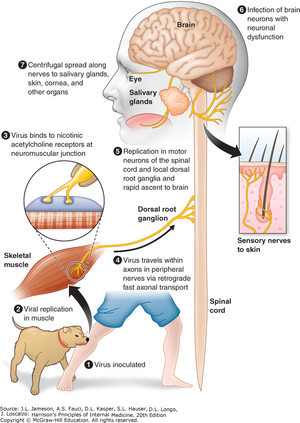
Rabies Lyssavirus, commonly known as the Rabies virus, is a type of neurotropic virus that causes rabies in mammals.[1]
Rabies virus is preventable for humans through vaccination or fast-acting shot that contains rabies immune globulin after one got bitten. Other mammals can also get the vaccination for the prevention of rabies virus.[2]Once the Rabies virus is transmitted through bite or saliva of rabid animals, it will transmit to the central nervous system(CNS)and infects the peripheral nerves. If bites from rabies-infected animals did not receive immediate care, and rabies symptoms start to appear in patients, it is usually fetal.
There is currently no cure for the Rabies virus, and it carries approximately 55,000 lives away each year.[3]
Structure
Rabies Virus (RABV) belongs to the family Rhabdoviruses and the genus Lyssavirus. RABV is a bullet-shaped RNA virus that is about 180 nm in length and 75 nm in width.The "bullet" contains one copy of a enveloped single-stranded non-coding RNA genome.[4]RABV genome encodes five essential structural proteins:
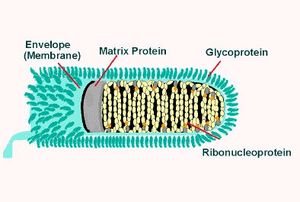
Nucleoprotein(N):
The nucleoprotein encapsidates the non-coding RNA genome to form the viral ribonucleoprotein complex (RNP). The resulting RNP is responsible for the protection of the rabies virus genome from RNA degradation caused by ribonuclease. Other than genome protection, nucleoprotein is also an antigen for viruses due to their group and strain-specific antigenic determinants.[5]
Phosphoprotein(P):
The phosphoprotein (P) plays a key role in the replication of RABV viral RNA by being the cofactor of an essential enzyme RNA-dependent RNA polymerase (RdRP). The phosphoprotein accomplishes the key RNA synthesis by connecting the nucleoprotein and the polymerase protein in the ribonucleoprotein complex.[6]
Polymerase protein(L):
Polymerase protein is responsible for the transcription of the RABV RNA. During transcription, the L protein will transcribe the viral RNA into leader RNA and five mRNAs that are each capped and polyadenylated. The RNA-dependent RNA polymerase protein is a potential target for rabies treatment because it produces all viral proteins for RABV and requires interaction with other viral proteins for the primary transcription.[7]

Matrix Protein(M):
It has been known for two decades that matrix protein is responsible for interaction with glycoprotein. M protein also recruit RNPs, whose condensation forms the budding of the bullet-shaped particles.[8] The membrane matrix protein is later known for being a factor for the balance of RABV transcription and replication through inhibiting transcription and stimulating the replication process.[9]
Glycoprotein(G):
Forms glycoprotein spikes on the outer envelope of the virus, which allows the virus to be recognized and aid in its binding to host cells.
The two significant components of the Rabies virus are the ribonucleoprotein complex(RNP) and the surrounding cell envelope.
Out of the five proteins, nucleoprotein(N), Phosphoprotein(P), and Polymerase protein(L) are associated with the RNP. The matrix protein is responsible for covering and keeping the RNP in a condensed form. The rabies virus envelope is constructed of a phospholipid bilayer with glycoprotein spikes.[10]
History
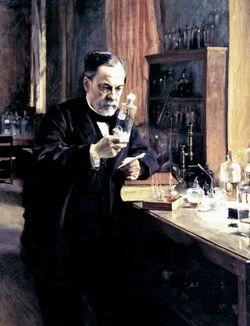
Rabies is an ancient disease. It was called "lyssa" by the ancient Greeks, which means violence. Rabies was first mentioned in text coming from the 2300B.C. when people in Babylon found the death of their dogs and humans were related to getting bid by a dog. If a Babylonians dog transmitted another person's rabies, they have to pay for it.
Back in the first century A.D., the transmission of rabies was correctly suggested by Roman scholar Celsus. The correct cure, however, is yet to be found even with the well-developed scientific field in the 21st century. Back in ancient times, various remedies are being suggested: Celsus suggested holding the patient underwater. Others have suggested laying the rabid dog hair on the patient or let the patient ingest rabid dog hair. Going into the 18th century, Madstones, which is hairballs found in the ruminants stomachs, were thought a valuable rabis treatment. It was reported that in 1849, Abraham Lincoln's son Robert was bitten by a rabid dog and survived with the madstone treatment.
The first treatment was introduced by Louis Pasteur, a french chemistry teacher. He discovered the first attenuated vaccine when he noticed the virulent cultures no longer caused disease after he dubbed with chicken cholera. The first human being treated successfully with this vaccine was a 9-year-old boy named Joseph Meister, who was scratched by a rabid dog. Joseph recovered after receiving 13 inoculations in 11 days. After the success in 1885, the post-exposure vaccine was widely used by over 20,000 people and is still being used as the standard post-treatment for rabies.[11]
Vaccination
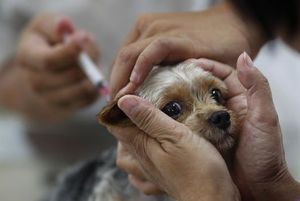
The rabies vaccine is universal today and is divided into preventive vaccination and post-exposure vaccination. Between 15,000 and 40,000 people are vaccinated each year after a possibly rabid animal bite. Bites from unvaccinated dogs cause most of the rabies-related death cases.[12]
Rabies virus is given to people as protection and prevention from the rabies virus, while the vaccination itself cannot cause rabies because it is made from the inactivated rabies virus. When the vaccine is being injected, the human body's immune system responds to the killed virus. After vaccination, the active immune response protects the body from further attacks from the same virus by responding rapidly to future encounters.
Rabies virus vaccination is also available for other mammals and in some parts of the world required for domestic pets.
Evolution
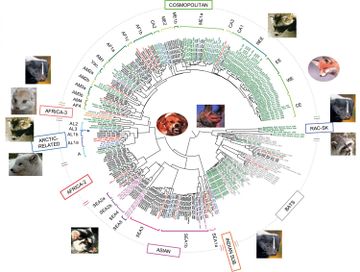
To be updated
Case Study
Although most of the untreated patients of rabies died, there were a few cases that stood out where the patient has not treated pre or post-exposure to the rabies virus, they still survived. We are going to focus on the story of Jeanna Giese.
Jeanna Giese
Jeanna Giese, then mentions other cases without detail, just to support.

Research
Research directions: permeability of the blood-brain barrier, central nervous system. Rabies virus outer shell, which is unable to cause disease, can be used in other medical fields.
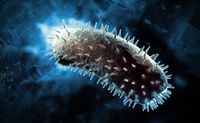
Conclusion
Overall text length should be at least 1,000 words (before counting references), with at least 2 images. Include at least 5 references under Reference section.
References
- ↑ Rabies - Symptoms and causes [Internet]. Mayo Clinic. 2019. Available from: https://www.mayoclinic.org/diseases-conditions/rabies/symptoms-causes/syc-20351821
- ↑ Rabies Vaccine [Internet]. Cdc.gov. 2009. Available from: https://www.cdc.gov/vaccines/hcp/vis/vis-statements/rabies.pdf
- ↑ Is Rabies Really 100% Fatal? | Viruses101 | Learn Science at Scitable [Internet]. Nature.com. 2013. Available from: https://www.nature.com/scitable/blog/viruses101/is_rabies_really_100_fatal/
- ↑ What is Rabies? | Rabies | CDC [Internet]. Cdc.gov. 2019. Available from: https://www.cdc.gov/rabies/about.html.
- ↑ Koser M, McGettigan J, Tan G, Smith M, Koprowski H, Dietzschold B et al. Rabies virus nucleoprotein as a carrier for foreign antigens. Proceedings of the National Academy of Sciences [Internet]. 2004;101(25):9405-9410. Available from: https://www.pnas.org/content/101/25/9405
- ↑ Okada K, Ito N, Yamaoka S, Masatani T, Ebihara H, Goto H et al. Roles of the Rabies Virus Phosphoprotein Isoforms in Pathogenesis. Journal of Virology [Internet]. 2016;90(18):8226-8237. Available from: https://jvi.asm.org/content/90/18/8226
- ↑ Nakagawa K, Kobayashi Y, Ito N, Suzuki Y, Okada K, Makino M et al. Molecular Function Analysis of Rabies Virus RNA Polymerase L Protein by Using an L Gene-Deficient Virus. Journal of Virology [Internet]. 2017;91(20). Available from: https://www.ncbi.nlm.nih.gov/pmc/articles/PMC5625484/
- ↑ Mebatsion T, Weiland F, Conzelmann K. Matrix Protein of Rabies Virus Is Responsible for the Assembly and Budding of Bullet-Shaped Particles and Interacts with the Transmembrane Spike Glycoprotein G [Internet]. Journal of Virology. 1999. Available from: https://jvi.asm.org/content/73/1/242.long
- ↑ Finke S, Mueller-Waldeck R, Conzelmann K. Rabies virus matrix protein regulates the balance of virus transcription and replication. Journal of General Virology [Internet]. 2003;84(6):1613-1621. Available from: https://www.microbiologyresearch.org/docserver/fulltext/jgv/84/6/1613.pdf?expires=1575256460&id=id&accname=guest&checksum=8E3AA286D649C7B0CAF0AAF05D0D07DC
- ↑ What is Rabies? | Rabies | CDC [Internet]. Cdc.gov. 2019. Available from: https://www.cdc.gov/rabies/about.html.
- ↑ 10. O'Niell F. A History of Rabies [Internet]. Tuckahoevet.com. Available from: https://www.tuckahoevet.com/post/a-history-of-rabies
- ↑ Rabies Vaccine [Internet]. Cdc.gov. 2009. Available from: https://www.cdc.gov/vaccines/hcp/vis/vis-statements/rabies.pdf
Edited by Yangyang Liu, student of Joan Slonczewski for BIOL 116 Information in Living Systems, 2019, Kenyon College.
